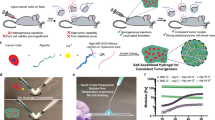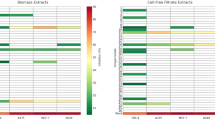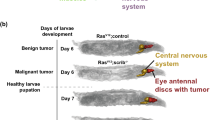Abstract
A COMPARISON between the malignant tumours of animals and the plant tumours, commonly called ‘crown gall’, is beyond the scope of the present article*. It may be pointed out, however, that characteristic histological and cyto-logical differences can be observed—obviously enough—between these two pathological structures, such differences being inherent in the two types of host organisms themselves. It may be added furtherthat the analogies of response of plants and animals, to be described, were obtained in spite of their structural differences.
This is a preview of subscription content, access via your institution
Access options
Subscribe to this journal
Receive 51 print issues and online access
$199.00 per year
only $3.90 per issue
Buy this article
- Purchase on SpringerLink
- Instant access to full article PDF
Prices may be subject to local taxes which are calculated during checkout
Similar content being viewed by others
References
Komuro, Hideo, Proc. Imp. Acad., Tokyo, 7, (3), 110–113 (1931).
Levine, M., and Bergmann, H., Amer. J. Cancer, 26, 291–315 (1936).
Levine, M., Bull. Torrey Bot. Club., 61, 103–118 (1934).
Levine, M., Bull. Torrey Bot. Club, 63, 177–199 (1936).
Levine, M., and Chargaff, E., Amer. J. Bot., 24, 461–472 (1937).
Cook, Hewitt and Hieger, J. Chem. Soc., 395–405 (1933).
Havas, L., Second Intern. Congr. Cancer, Brussels, 436 (1936).
Auler, H., Z. Krebsforsch., 22, 393–403 (1924).
Parventjev, Devrient and Sokoloff, Proc. Soc. Exp. Biol., A, Med., 28, 538 (1931).
Vles, F., and Coulon, A., Arch. Phys. Biol., 9, 245–260 (1932).
Suzuki, K., and Miyaois, Trans. Soc. Path. Jap., 671–679 (1933).
Havas, L., Bull. Cancer (Paris), 26, 1–28 (1937).
Loeb, Leo, J. Amer. Med. Assoc., 104, 1597 (1935).
Fodor, Eros and Kunos, Gyogyaszat., 73, 1–31 (1933).
Havas, L., NATURE, 136, 516 (1935).
Stapp, C., Zbl. Bakt., 96, 81–92 (1937).
Hayashi, N., Trans. Jap. Path. Soc., 20, 20 (1930).
Engel, H. Z. Krebsforsch., (1923); Med. Klin., 2, 120 (1930).
Reiss, Druckery and Hochwald, Klin. Woch., 27, 1049 (1933).
Gordonoff, T., and Ludwig, F., Z. Vitaminforsch., 4, 213–223 (1935).
Fodor and Kunos, Z. Krebsforsch., 40, 567 (1934).
Havas, L., NATURE, 136, 989 (1935).
Dustin, A. P., Leeuwenhoek Ver. IVe Cong., 7 (1935).
Peyron, Lafay and Kobozieff, Bull. Cancer (Paris), 25, 874 (1936).
Koch, Fr. E., Z. Krebsforsch., 47, 325–335 (1938).
Verona, O., and Paganini, M., Arch. Inst. Biochim. Ital., 3, 1–8 (1938).
Author information
Authors and Affiliations
Rights and permissions
About this article
Cite this article
HAVAS, L. Growth of Induced Plant Tumours. Nature 143, 789–791 (1939). https://doi.org/10.1038/143789a0
Issue date:
DOI: https://doi.org/10.1038/143789a0
This article is cited by
-
Chemically Induced Neoplasms in Fungi
Nature (1956)



